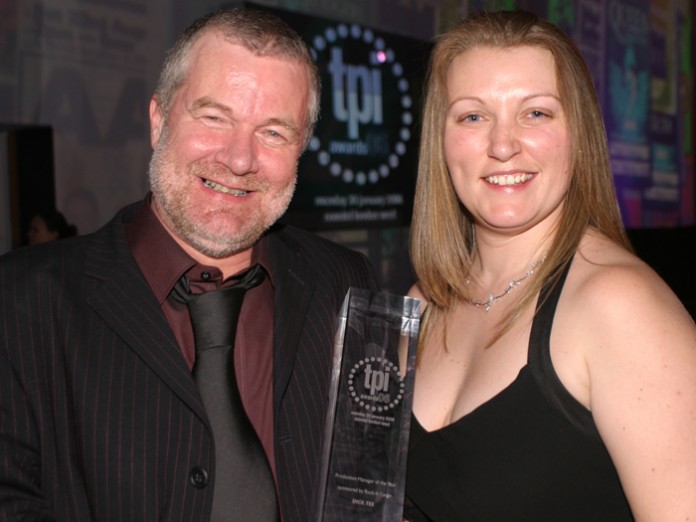
Over the course of the last 35 years, EnTEEtainment has provided site coordination, event management and production services to everything from Glastonbury Festival to the Scottish Bagpipe Championships. Its founder Dick Tee recently celebrated his three and a half decade anniversary in the live events industry, and spoke with Festival Insights about the trajectory of his career, his opinions on CDM guidelines, and projections for the future of festivals.
At the tail end of the Ziggy Stardust tour on June 24 1973, a teenager named Dick Tee saw a man named David Bowie perform at Fairfield Halls in Croydon. Twenty-seven years and a day later, Bowie was in the passenger seat of a battle-scarred Land Rover on a tour of the Glastonbury site. The festival’s production manager for the Pyramid and Other stages, a man named Dick Tee, was in the driver’s seat. A few hours later, Tee was stood stage right for Bowie’s triumphant headline slot on the Pyramid Stage.
The original plan was to go into farming. Six months into agricultural college, however, a duality of interests emerged when Tee was elected onto the entertainment committee and appointed Social Secretary, a position that he kept for nearly four years and used to undo the monopoly that “folk and barn dances” had on the local music scene. As he lacked the farming background of his peers, the only agricultural work on offer post-graduation involved driving round the countryside as a roving fertiliser merchant – and so events work began as a means to be able to purchase his own farm. His entry point into the industry came courtesy of Mecca Leisure, for whom he ran Streatham’s Silver Blades Ice Rink and Bali-Hi High nightclub.
As far as eventful first days on the job go on a scale of one to ‘some guy showed up with an axe’, it was the latter end of the spectrum that summed up Tee’s at Bali-Hi, when some guy showed up with an axe. “I lasted about six months there,” he said.
The impetus for Tee’s departure – heavily armed oddballs notwithstanding – was through securing the role of Entertainment Officer with the National Union of Students’, which Tee would maintain for three and a half years at its head office in London. During this time he kept busy: running training courses to teach social secretaries how to put on events, setting up the campus-touring show Rock Goes to College with the BBC, as well as putting together a small directory of production companies that acted as a precursor to The White Book.
Having set a solid foundation with the NUS, his first foray into concert promotion took the form of a Q-Tips show at the Lyceum Theatre in London. Funding the venture would take some relatively substantial capital, so Tee offered the keys of his Triumph TR-7 to his bank’s manager as collateral, in exchange for an overdraft of £2000. Ostensibly impressed by his audacity and affable charm, she accepted. As for the show, not only did no one turn up with an axe, but it made a profit of £86, giving him the push to create the initial iteration of his eponymous company, then dubbed That’s EnTEEtainment.
Concurrently, and in a similarly entrepreneurial spirit, he made an offer to the NUS to purchase the rights of the then-nameless production directory he’d been developing, to which they said ‘no’. Included in the bid was the promise was to provide every social secretary in the country with a free copy every year, a perk the NUS lost out on when Tee “changed the typeface, moved the data around, re jigged the format, and called it The White Book”.
The following years were split evenly between the running of the publishing company and working on events. The two endeavours turned out to be symbiotic, with the publisher’s new office at Shepperton Film Studios introducing Tee to Harold and Barbara Pendleton – the pair in charge of the Marquee Group that encompassed not just the club of the same name but Reading Festival. Looking after artist liaison and the dressing rooms, Tee undertook his first festival work there and met Melvin Benn, whom he also worked with in a similar capacity on both The Phoenix Festival and The Fleadh festivals.
In the mid-late ’90s That’s EnTEEtainment expanded its palette with a range of corporate work on the likes of Marks & Spencer’s lingerie modelling shows and the Ministry of Defence-funded Festival of the Sea. Perhaps conscious of who might be reading, Tee rather wisely refrained from waxing poetic too much about the former contract, but happily recounted the creative license and resources that The Festival of the Sea provided him with. The cinematic style of the festival’s setup allowed him to indulge a penchant for the theatre inherited from both his father and grandfather. Theatricality aside, the Festival of the Sea led Tee to make the acquaintance of Mike Richmond, and the two would soon set up the Event Safety Shop together. Despite chalking up the venture’s success to “being at the right place at the right time”, the Event Safety Shop neatly filled a gap in the market providing advice on health & safety legislation tailored purely to events. The bespoke safety advice and consultancy business grew over a period of years before Tee sold his shares.
Similarly, he parted ways with The White Book in 1996, and shortly after migrated from Reading to looking after the Pyramid and Other Stages at Glastonbury at Michael Eavis’ request. Over the course of the following 18 years, EnTEEtainment helped overhaul the entire managerial and logistical sides of the festival, effectively professionalising what was originally a “team of well intentioned, passionate, but mostly amateur” individuals. Although Glastonbury now boasts world-class infrastructure – comprising masses of internal roadways, million-litre water reserves and so forth – the festival Tee was introduced to bore little resemblance in that regard.
Probably for the best, he wasn’t fully cognisant of “how much the eyes of the world” were on him in those days. In the years since, the production values of the festival have continued to evolve; beginning with the central hub that Tee was responsible for and gradually percolating outwards to the festival’s plethora of peripheral elements. Tee also returned to Reading Festival during his Glastonbury tenure, and further diversified EnTEEtainment’s client list with events that took him from Rochester Castle to Moscow’s Red Square. There in heart of the Motherland, Tee saw Roger Waters perform Dark Side of the Moon. Waters, coupled with Bowie and ELO, completed the triumvirate of musicians that Tee held dear as an adolescent and would later see from the side of the stage.

EnTEEtainment, of course, is not a one-man operation; a network of trusted freelancers accompanies the small and dedicated core team of full-time staff, which includes Production Co-Ordinator Amy Harmsworth, who has worked alongside Tee since 2004. Maintaining good relationships with prospective contractors, clients, and suppliers, is paramount to success, according to Tee: “Loyalty, decency, and honesty are critical qualities to have in the industry. We’re always very up front about costs and the time it’ll take us to get the job done, which might be why we’re not as rich as some of our competitors. I think I hear the world’s smallest violin coming out there.”
Dick’s daughter Frankie has become increasingly integral to the operation over the last eight years, becoming a “very competent” Production Coordinator and occasional Production Manager, gradually taking on more executive decision-making in the process. Frankie’s standard role on a festival involves preparing the artists’ technical packs, dealing with agents, managers “and whoever else”; coordinating rolling riser specs; go through desk requirements on P.A and audio; and “pulling all of that technical side together”. Much in the way that Dick brought Glastonbury into the 21st century, Frankie overhauled EnTEEtainment’s IT and admin side, setting up its internal ‘TeeTotal’ database and persuading her father to “finally” update the company logo.
Aside from the patently obvious technical advancements that festivals have made in the last couple of decades, another significant change Tee alluded to is the lateral movement that programming has taken, epitomised rather fittingly by the Festival Republic-run Latitude. The event’s eclecticism and refusal to recycle headliners has made it a vanguard of the boutique festival movement, and Tee cites it as an example of how much more family-friendly and diverse festivals have become. “The original festival-going generation is around my age, and now that they have a good deal of disposable income a lot of them would like to return to the scene. With events like Latitude, The Big Feastival, Carfest, Henley Festival and so on, they can. There’s something for everyone now, especially considering how much better the camping and food options have become.”
The advent of ‘hybrid’ festivals – ones that give equal billing to music and another critical component – is something he attributes to the industry’s continued growth, however he concedes that the market is saturated. “I foresee that in the next five or ten years we’ll see a gulf emerge between the giants of the festival world who can afford the biggest acts, and the more innovative niche events that do things differently enough to attract a loyal following. It’s the ones in the middle that will suffer, I think, because they might not be unique or influential enough to pull in an audience from further afield.”
The initial response to my question of how health & safety has changed since the beginning of his career was one of incredulous laughter, followed by the word ‘completely’. The HSE’s implementation of the Construction (Design and Management) Regulations in April 2015 represents perhaps the most sudden and seismic shift in the industry’s adherence towards health & safety, and Tee welcomes the standardisation that codified health & safety practices inevitably bring.
However, when the enforcers of those guidelines have nothing more than a superficial understanding of why the rules exist, it can lead to conflict with those responsible for making things happen. “That’s something that frustrates me, when I hear ‘You can’t do that because of health & safety’, without elaboration. Health & safety shouldn’t be weaponised to stop things happening like that, especially in such a vague and arbitrary way.”
The government’s more recently introduced Legal Series guidance, a supplementary paper aiming to clarify the CDM guidelines, includes more diagrammatic explanations and graphical representations of its parent document’s stipulations. “It’s helpful,” said Tee. “But like any other legislation it’s mostly common sense and best practice.”
Furthermore, he has yet to be convinced that actual working practices in the industry have changed significantly as a result, a testament to how consummate its professionals were even without their responsibilities being made explicit. According to Tee, health & safety and rock ‘n’ roll aren’t as diametrically opposed as one might assume: “I think our record in events is actually very good. Farms, for example, are much more hazardous environments than festivals, but whenever a live event goes wrong it just so happens to be heavily publicised.”
One such infamous [near] disaster was Fatboy Slim’s Big Beach Boutique II on Brighton Beach in July 2002, whose organisers anticipated between 10,000 – 20,000 attendees for what was to be a free event exclusively advertised in local circles. Unfortunately, the words ‘Fatboy’, ‘Slim’, ‘free’, and ‘beach’ apparently weren’t considered sufficiently compelling to attract a crowd, and so the show was advertised via radio and printed press. One of the event safety officers at the resulting lucid nightmare of an event was, predictably, Tee. “I drew the short straw,” he said.
As a result of its gratuitous advertising campaign and highly agreeable weather conditions, an estimated 250,000 smiling faces showed up. Average density levels were supposedly five people per square metre, but owing to an anomalous level of cooperation from the crowd, no one lost their life as a result of the concert.
“Fortunately, a rising tide cleared out a good deal of the audience as well,” Tee said. After a brief pause he clarified that they left of their own volition, and weren’t dragged into the cold embrace of Poseidon. At the conclusion of Big Beach Boutique II, Tee’s repeated Zen-like assurance of ‘Go with the flow’ to the departing revellers can be heard sampled at the end of its accompanying compilation album. “I’m still awaiting royalties on that,” he said.




